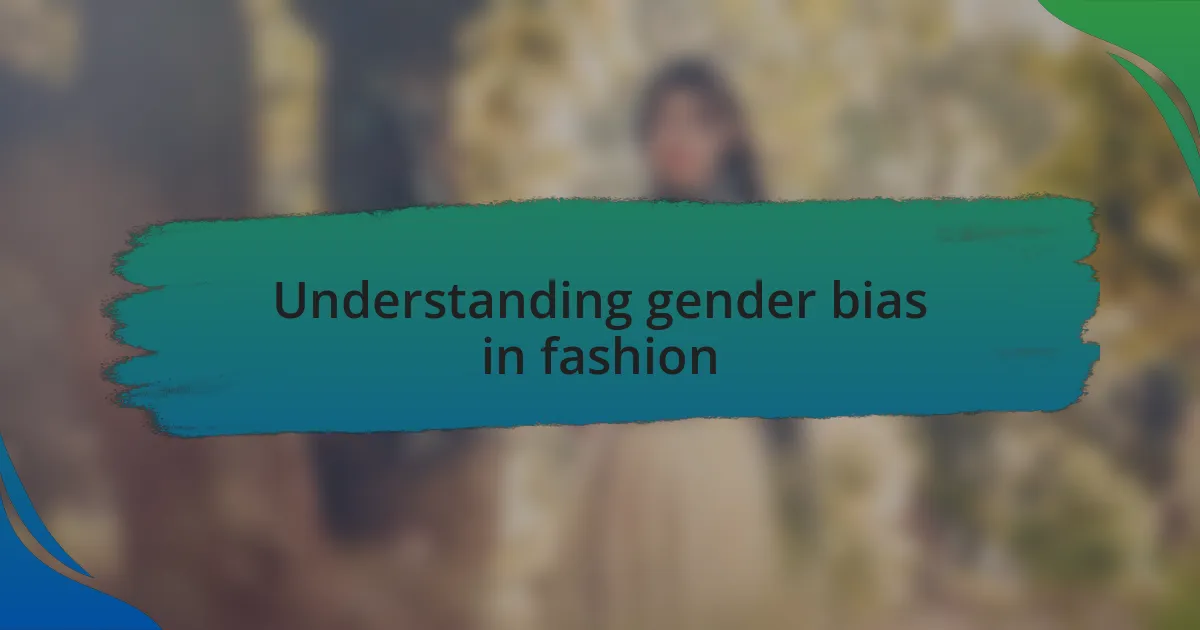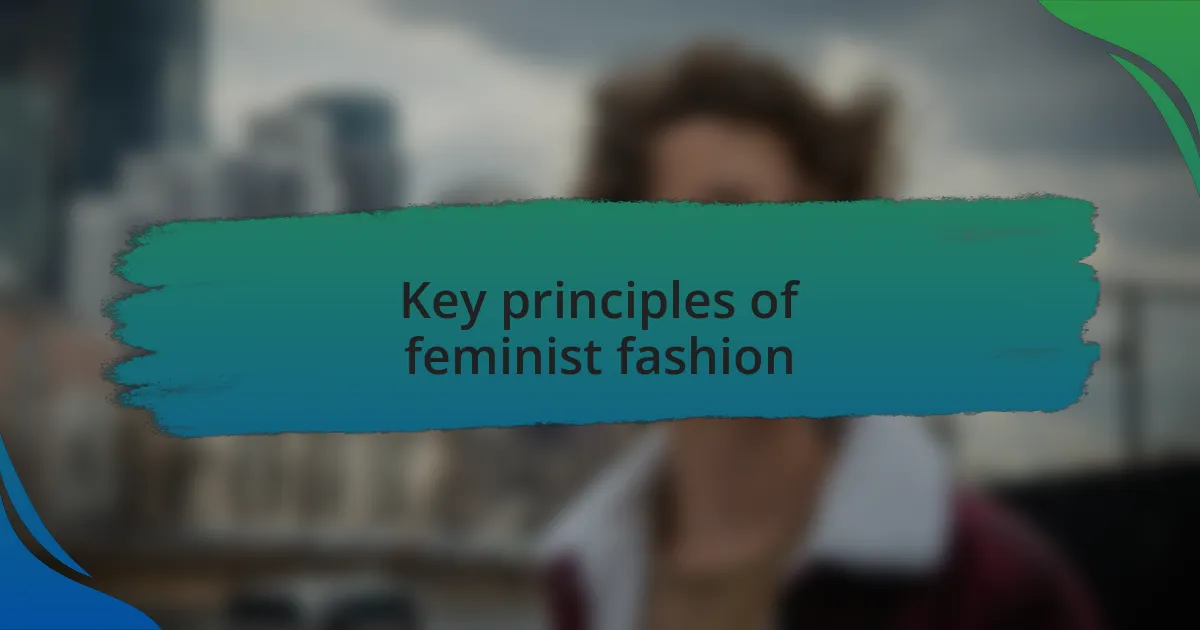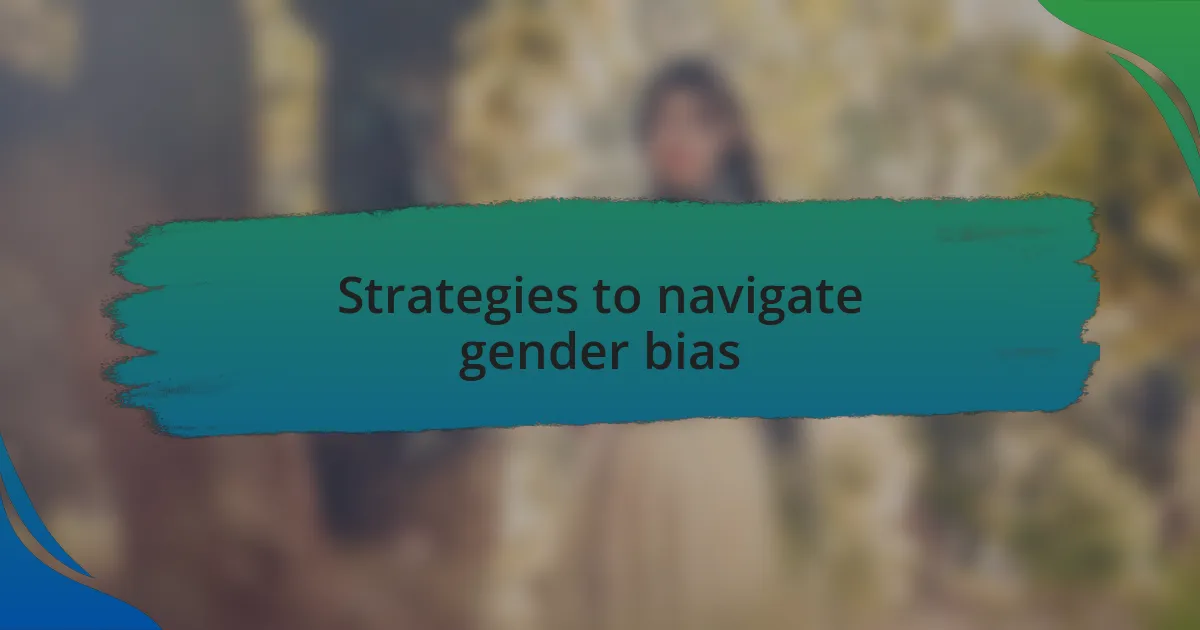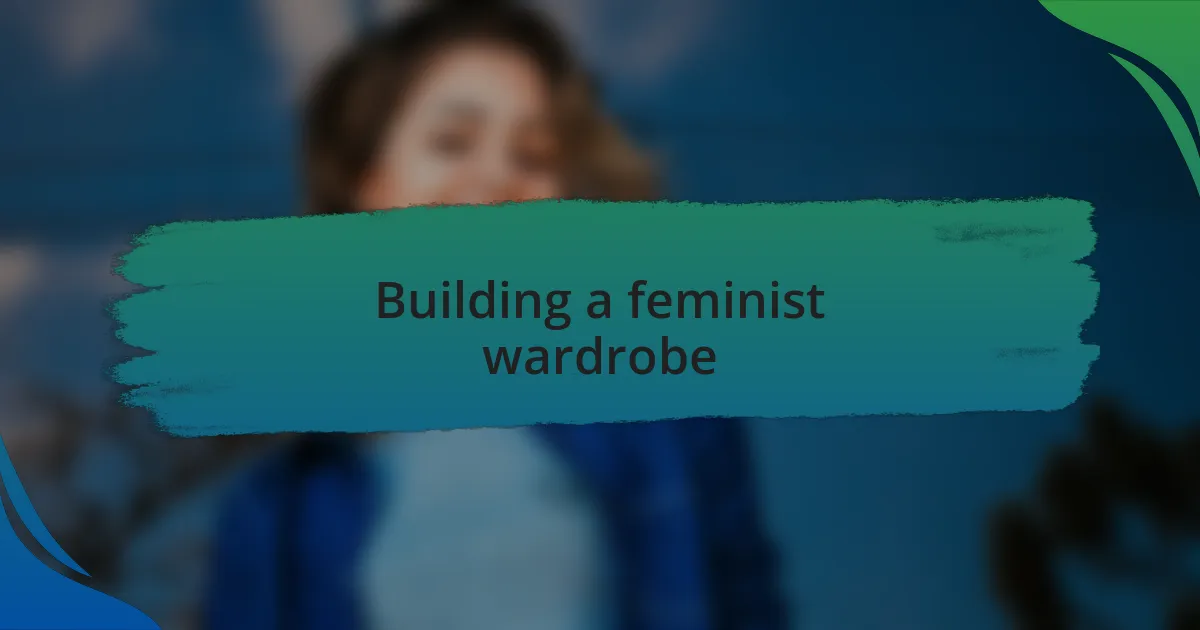Key takeaways:
- Gender bias in fashion manifests through societal norms that restrict self-expression and exclude diverse identities.
- Feminist fashion promotes inclusivity, ethical production, and personal agency in style choices, encouraging individuals to break traditional norms.
- Building a feminist wardrobe involves intentional choices that reflect personal values, supporting sustainability and self-empowerment through fashion.
- Community support and advocacy for diverse representation are essential strategies for navigating and challenging gender bias in fashion.

Understanding gender bias in fashion
Gender bias in fashion is often apparent in the way society dictates styles and preferences based on gender. For instance, I remember shopping for clothing and feeling a distinct difference in how pieces marketed toward women were often designed to accentuate traditional roles—think overly frilly dresses versus more functional gear marketed to men. Isn’t it ironic that something meant for self-expression can feel so restrictive?
Moreover, the representation of diverse bodies and identities in fashion highlights the bias that persists within the industry. I’ve often found myself frustrated when browsing through lookbooks that lack inclusivity, essentially sidelining countless individuals, including myself at times. It raises the question: how can we truly embrace fashion as a form of freedom if it perpetuates constraints around gender and size?
Finally, it’s crucial to recognize that these biases aren’t just about clothing choices; they can impact self-esteem and confidence. When I wore something outside the norm, like a tailored suit, I felt both empowered and anxious, aware that the societal gaze often scrutinizes those who defy traditional expectations. How many of us have hesitated to express who we really are because of the fashion norms imposed upon us?

Key principles of feminist fashion
Key principles of feminist fashion center on inclusivity, empowerment, and self-expression. One fundamental aspect is the commitment to diversity in sizing and representation. I recall the exhilaration I felt when I discovered brands that celebrated all body types, showcasing models of various shapes and abilities. Isn’t it liberating to see oneself reflected in the fashion choices presented to the public?
Another crucial principle is the emphasis on sustainability and ethical production. I’ve often wrestled with the dilemma of supporting fast fashion, which often exploits labor, versus investing in pieces that respect both the workers and the environment. Choosing to buy from brands that prioritize ethical practices not only aligns with feminist values but also empowers me to make a statement about the kind of fashion I want to endorse.
Lastly, feminist fashion advocates for personal agency in style choices. I remember the first time I paired combat boots with a flowing skirt—it felt like a radical act of rebellion against conventional norms. It made me reflect on how fashion should be a medium for expressing one’s true self, regardless of societal expectations. How can we tap into our authentic selves if we’re confined by outdated definitions of femininity?

Personal experiences with gender bias
Navigating gender bias has been a prominent part of my journey in both personal life and fashion. I vividly recall a time when I worked in a predominantly male environment where my ideas were often overlooked. It wasn’t just frustrating; it made me question whether my contributions were seen as valid simply because of my gender. Have you ever felt that sinking feeling of being dismissed in a space where you should feel empowered?
In another instance, I experienced subtle bias while shopping for clothes. I remember browsing a department store and overhearing a salesperson casually suggesting more “feminine” options to a male customer, while ignoring my visible interest in gender-neutral attire. That moment was a wake-up call, reminding me how entrenched stereotypes can shape our choices in fashion and beyond. Why is it so hard for some to accept that style knows no gender?
Through these experiences, I’ve realized that gender bias isn’t just a personal struggle; it’s a societal issue woven into the fabric of our daily lives. Each encounter, whether trivial or profound, shapes how I perceive the world of fashion. I often wonder, how can we reclaim our narratives against such bias? Embracing feminist fashion has given me a platform to voice my identity and challenge these normative expectations.

Strategies to navigate gender bias
When facing gender bias, one effective strategy is to seek out and build supportive communities. I recall attending a local fashion event where I connected with like-minded individuals who shared my experiences. It was refreshing to engage in open conversations about bias and empowerment, which not only validated my feelings but also fostered a sense of solidarity that was incredibly uplifting. How often do we underestimate the power of community in overcoming challenges?
Another approach I’ve found useful is to actively challenge stereotypes in both my wardrobe and conversations. For instance, I decided to wear pieces that blend traditionally masculine and feminine styles, intentionally sparking discussions about what clothing can represent. This not only encouraged others to rethink their choices but also made me feel confident in breaking the mold. Have you ever noticed how a bold outfit can prompt dialogue and shift perceptions?
Additionally, advocating for diverse representations in media and fashion is crucial. I remember feeling invigorated when I supported brands that prioritize inclusivity in their campaigns. Seeing models of various genders and body types helped me feel seen and inspired me to advocate for change. Have you thought about how your shopping choices contribute to wider societal shifts? By aligning ourselves with inclusive fashion, we can challenge the status quo and create a ripple effect of change.

Building a feminist wardrobe
Building a feminist wardrobe involves making intentional choices that align with our values. One of my favorite strategies is thrift shopping. I’ve often found unique pieces that not only express my individuality but also support sustainable fashion practices. How can we forget the thrill of finding a vintage dress that tells its own story? Each piece I add is a conversation starter about empowerment and self-expression.
Incorporating brands that prioritize ethical production is also vital. I remember the excitement I felt when I discovered a small, women-owned label that emphasizes fair labor practices. Wearing their clothes not only made me feel good because of the quality but also because I knew my purchase supported a mission I believe in. Have you ever bought something that felt like it was a part of a larger movement? That connection can transform the way we view our wardrobe.
Finally, I think it’s essential to embrace colors and styles that resonate deeply with us. I once wore a bold red outfit to an event, and it evoked a sense of power I hadn’t expected. It made me wonder—why do we often shy away from colors that reflect our inner strength? Building a feminist wardrobe isn’t just about clothing; it’s about creating a personal arsenal of self-affirmation and confidence.